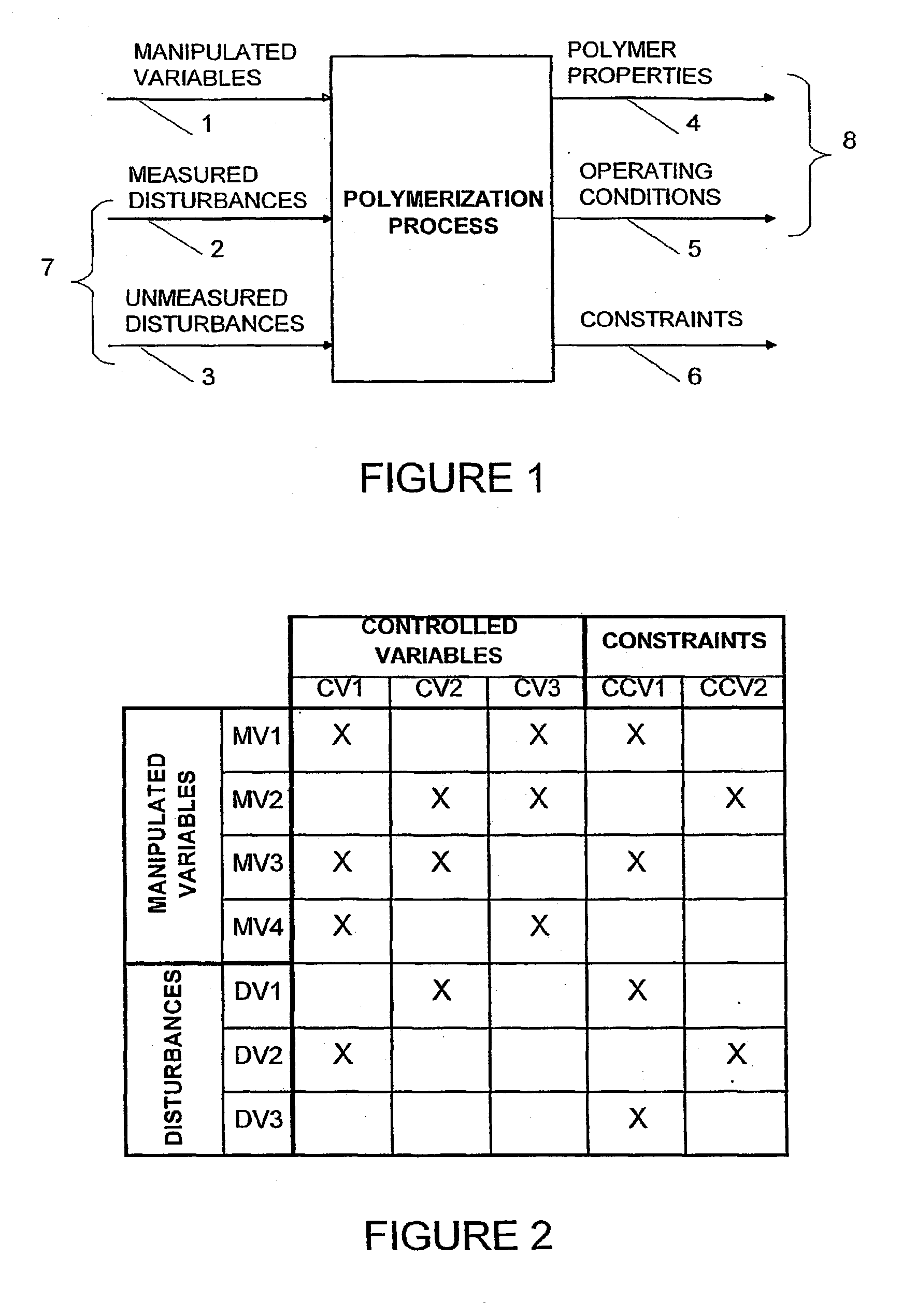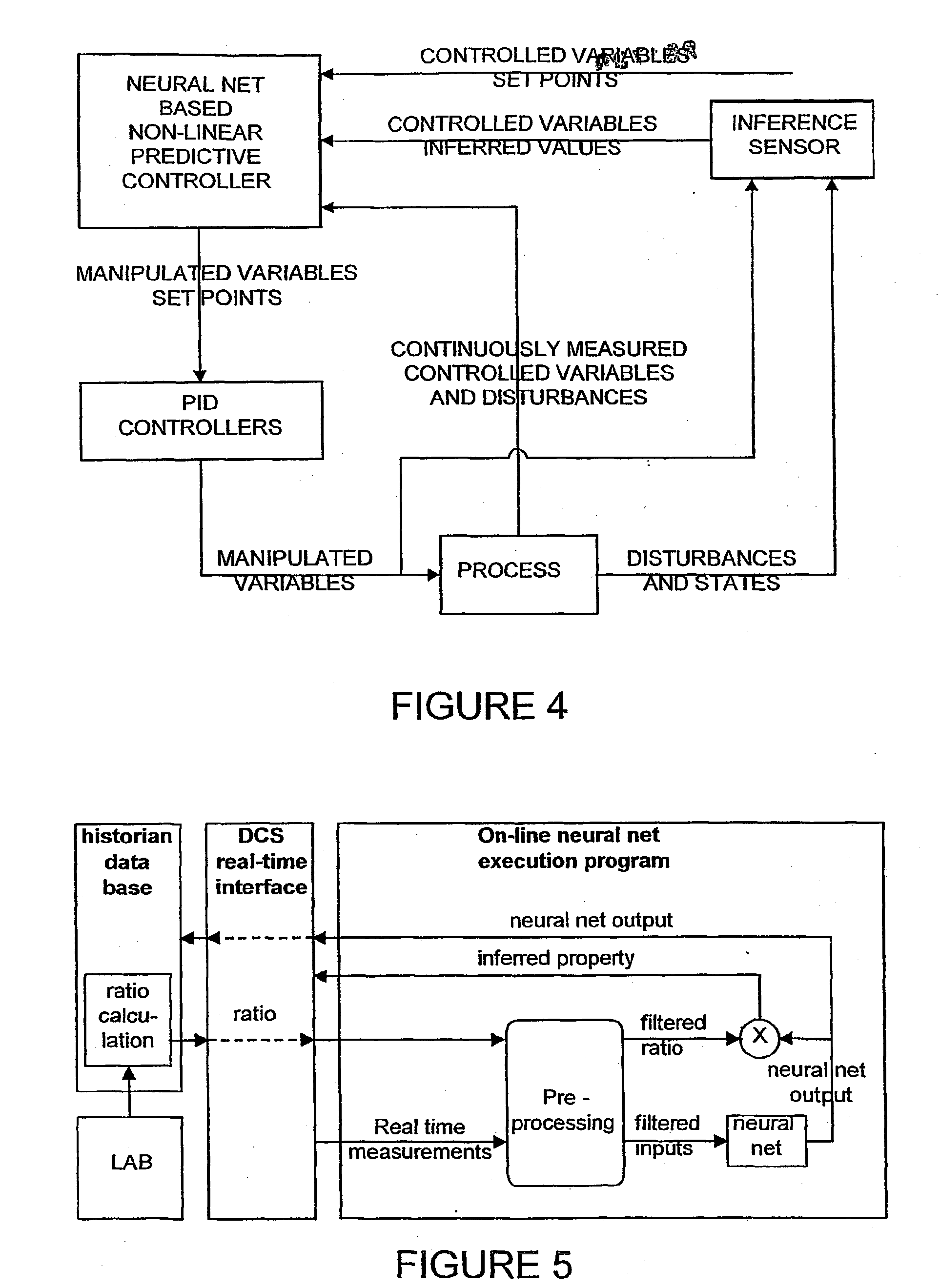This involves delays related to required corrections, since the sampling and laboratory tests normally
lag the on-line process, besides possible human errors.
Further, the dynamics of
petrochemical processes is generally slow.
Therefore, the slow dynamics is a feature which renders difficult the control of the industrial unit since the worker may not know if there has been a
sufficient time for the effects of the performed adjustments to be apparent or either if more time is required so that said effects are completely perceived.
As compared to the empirical techniques, the rigorous models are more difficult to construct and require a
deep knowledge of the process.
Besides, the complexity of the equations, which make up the rigorous model, may render it, at least in some cases, unsuitable for on-line implementation, this difficulty arising from the long time to resolve such equations, even making use of computers.
A
disadvantage of the empirical models is that they cannot be used under operating conditions different from those used in their identification.
The
control system which is unable to deal with constraints will not be able to guarantee the safety and the operational continuity required for an industrial unit to accomplish its goals.
The problem addressed by the cited application is the control of
reagent concentrations in the reactor, which is a gas /
liquid phase reactor.
The problem with such a strategy is that these control loops are coupled since
comonomer also affects the flow properties and
hydrogen also affects density.
However, said U.S. patent does not teach how to apply the described
system to
polymerization process nor teaches any control structure which might be particularly applied to the process for producing
polyethylene and its copolymers.
It is usual to have some limit in regard to the variation rate of MV since for certain variables it may not be safe to promote large adjustments in a short period of time.
Disturbances generally arise from known causes but it is not easy to eliminate them since they are originated by parameters which are extraneous to the process.
In many cases there are no analyzers which could be directly connected to the process and there are cases where in
spite of the fact that the technology for the measurement of such variables is available, the cost of the sensors may render its use impractical.
This way, during the period between one test and the following one, there is no indication whatsoever of the quality of the product, this causing a gap between the possible alterations in the variables and the implementation of whatever corrections which might be deemed necessary.
Thus, the flow rate of catalyst could be manipulated to control the reactor
production rate; however, whenever the polymerization heat overcomes the limit of the heat exchange capacity of the reactor, the objective of a further increase in production should be restricted in favor of the
thermal stability.
Polymerization processes show a high interaction degree among the various process variables, which renders difficult the task to pursue several control goals at the same time.
Although it is possible to control the
plant using static process models, this is not the most efficient alternative, since the adjustments should be performed slowly in view of the fact that the model does not contain information on the rate at which the process responds to said adjustments.
When the
plant is operated in the above-described manner, it is relevant to control the temperature of the
bubble point of said
stream, since if this value is much higher than the reactor temperature, because of an excessively
high concentration of heavier constituents, there may be not enough heat to completely vaporize the liquid which enters the reactor, this causing operating drawbacks.
Said CV is limited by the heat exchange capacity of the
system, where the control is effected by the opening of the temperature adjustment valve, which serves as a constraint to the
control system.
Were this constraint not followed, the flow rate of catalyst could increase excessively causing that the
temperature control valve stayed completely open, with the consequence that the temperature would be out of control and the unit would have to be
shut down.
In the state-of-the-art technique such property is assessed through periodical collections, this causing a
time gap between the instant of the measurement and what actually occurs in the
plant.
If the water gets to the
cooling tower at a very high temperature the
tower does not succeed in cooling the water as required and said water returns to the heat exchange
system of the reactor at a temperature which is still too high.
If the temperature of the water which is directed to the
heat exchanger is too close to the temperature at which the water exits the
heat exchanger, the temperature gets out of control since the water which reaches the
heat exchanger loses the capacity of withdrawing heat.
Generally in this case the
temperature control valve eventually is completely open in trying to withdraw more heat, however this is useless since there is no point in opening the temperature valve if the water which enters the heat exchanger is still too hot.
 Login to View More
Login to View More 


